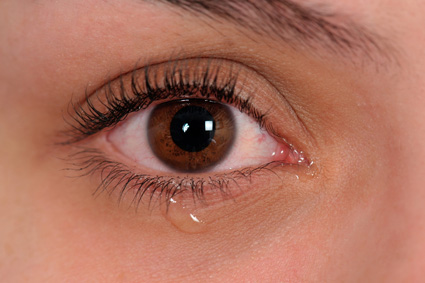Making Contact: New Lenses May Have the Potential to Monitor Chemical Composition of Tears
by Shannon Fischer
Non-invasive, conveniently ubiquitous, and in constant contact with tear fluid, contact lenses are one of the most appealing ways to monitor chemicals in tears.
“This technology could be used not only for chronic conditions but also after surgery or during the course of treatment. During a clinical trial, a specific chemical could be continuously monitored,” says Ali Yetisen, who recently reviewed the field of diagnostic contact lenses.
A basic lens has to meet a certain number of criteria. It needs to be made of a soft, comfortable material, like a hydrogel. It can’t cause irritation, it needs to allow for a certain amount of oxygen and tear fluid to pass through to the eye, and it has to be able to withstand constant physical stresses from the wearer’s eye movements and blinking. A smart lens designed to monitor physical variables needs to be able to do all of that, with the added challenge of making sure the sensor is protected, has access to tears, and can’t irritate the eye lest it throw off the concentration of chemicals in the tears.

“In principle, it is challenging, but it’s not all that challenging” says Sanford Asher, pointing to the fact that people have been successfully making and wearing contacts for nearly a century, and the manufacturing know-how there is well-established. More important is the fact that these sensors must be rapid, reversible, long-lasting, and, if necessary, somehow powered with electricity.
Several years ago, Asher’s group at his lab at the University of Pittsburgh designed a simple, glucose-sensing lens based on photonic crystals that functions without requiring power. It works a little bit like an opal, he explains. “If you have an opal, it’s composed of an array of particles of sand, and it shows ‘fire’. But if you were to change the array spacing, that directly changes the color diffracted and the perceived color would change.” For his lens, he embedded a similar array of particles in a soft hydrogel lens, out of the visual field. The gel contained chemicals able to bind to glucose, and once bound, they forced the lens to expel water, changing the array spacing, thus changing the perceived color of the lens. It was quick, reversible, and lasted at least a week—a typical length of time for contacts use. Supply a wearer with a color chart for comparison, and in theory, they would be able to peek in a mirror, compare the color of their lens and quickly assess the state of their glucose concentration. “It’s actually simple chemically, and simple in terms of the interaction with light,” Asher says.
Other types of sensors that have emerged in recent years, based on holographic and fluorescent sensors work similarly to Asher’s crystals. Electrochemical sensors, on the other hand, tend to be a little more complicated. Babak Parviz, an affiliate professor at the University of Washington and co-founder of Google’s Smart Contact Lens program (he is now with Amazon.com), reported in 2011 on his work with another type of glucose-sensing contact lens. This prototype consisted of a soft polymer lens, outfitted with an enzyme-based sensor to detect and produce an electrochemical reaction in response to glucose, plus tiny metal electrodes laid out in a pattern of concentric rings around the lens. Accompanying the lens, the lab also reported on a preliminary wireless power delivery system that used electromagnetic radiation delivered from up to 15 centimeters away. The researchers anticipate someday also using wireless mechanisms to download the sensed information. Google and Novartis have explicitly detailed their intent to wirelessly connect their smart lens to mobile devices, and several of Google’s contact lens patents already include this step.
Although as Yetisen cautions, all of that is still far in the future. “The fundamental science is not there yet,” he says. “We don’t want to put the cart before the horse.”
Shannon Fischer is a freelance science writer based in Boston. This article is part of a larger feature on the eyes and health, which can be found here.






